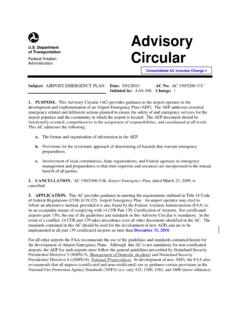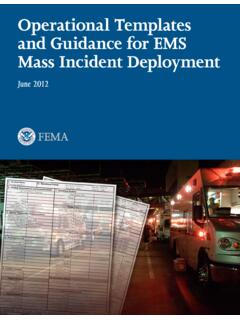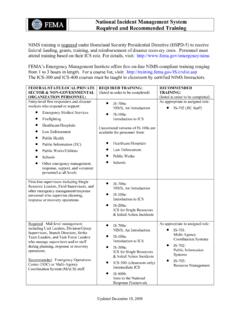Transcription of Lessons Learned - from the Deepwater Horizon Response
1 Lessons Learned from the Deepwater Horizon Response national Institute for Occupational Safety and Health December, 2011. Department of Health and Human Services Center for Disease Control and Prevention . national Institute for Occupational Safety and Health Cover photos by Rob Wolfe and Aaron Sussell, courtesy of NIOSH. Lessons Learned from the Deepwater Horizon Response national Institute for Occupational Safety and Health December, 2011. Department of Health and Human Services Center for Disease Control and Prevention national Institute for Occupational Safety and Health Foreword The explosion on the Deepwater Horizon disaster oil rig on April 20, 2010 resulted in the death of 11 workers and injury to another 17 workers. In the weeks and months after, as large amounts of crude oil released from the Macondo Well, tens of thousands of workers engaged in on- and off-shore containment and clean-up activities.
2 Address- ing concerns about the potential effects of the spill on human and environmental health in the Gulf, including potential risk to Response workers, prompted an unprecedented Response from agencies all across the Federal government. On May 3, 2010, experts from the national Institute for Occupational Safety and Health (NIOSH) arrived on site at the Gulf of Mexico. The role NIOSH had in this interagency effort was to anticipate and address the occupational safety and health needs of the containment and cleanup Response workers in close collaboration with the Occupational Safety and Health Administration (OSHA). As part of these activities, NIOSH led efforts in rostering workers, conducting health hazard evaluations, providing technical guid- ance by means of a joint OSHA/NIOSH publication, conducting health surveillance activities, and performing toxicity testing.
3 The Deepwater Horizon Response (DWHR) effort presented unique challenges in pro- tecting Response workers spread across the Gulf region, who performed a wide range of activities in physically and emotionally demanding circumstances. The DWHR presented opportunities to further expand our knowledge and understanding of protecting work- ers in complex, large-scale emergency responses. With the publication of Lessons Learned from the Deepwater Horizon Response , NIOSH hopes to share the knowledge gained during this Response (including the application of knowledge gained from past large-scale emergency responses), report how we can improve our Response to similar events in the future, and facilitate a dialogue between NIOSH and partners in the government, industry, labor and academia on ways to improve the overall Response to both natural and man-made disasters.
4 As we build our knowledge of what happens during the Response to disasters, so too will we increase our understanding of how to protect Response workers. John Howard, MD. Director, national Institute for Occupational Safety and Health Table of Contents Executive 1. NIOSH Response 6. NIOSH Rostering 6. Conducting Health Hazard Evaluations (HHEs).. 8. NIOSH Technical Guidance and 8. Health 9. NIOSH Toxicity Testing Related to the Deepwater Horizon 10. Lessons - Learned 11. General Deployment 11. Rostering 12. Conducting Health Hazard Evaluations (HHEs).. 13. NIOSH Technical Guidance and 14. Health Surveillance 14. Other Health Assessment 15. Biological Monitoring .. 15. Long-Term Studies .. 15. Mental Health .. 16. Follow-up Actions and Next 17. 18.
5 Executive Summary Following the unprecedented federal Response to the Deepwater Horizon (DWH). disaster, the national Institute for Occupational Safety and Health (NIOSH) conducted a review of the Institute's Response activities. The purpose of this report is to evaluate those Response activities, and in light of knowledge gained, identify ways to improve our Response in the future. This report is organized by first providing information on NIOSH Response activities, followed by several sections containing Lessons - Learned information, and ending in a discussion about next steps. Occupational safety and health experts from NIOSH arrived on site in Response to the oil spill on May 3, 2010, at the invitation of the Occupational Safety and Health Admin- istration (OSHA), as part of the federal interagency effort to anticipate and address the occupational safety and health needs of containment and cleanup Response workers on the Gulf Coast.
6 The unprecedented circumstances and magnitude of the disaster posed numerous challenges for NIOSH. NIOSH staff deployed to multiple locations in the five-state Gulf region; coordinated cross-agency and interagency operations in Atlanta, GA, and Washington, DC; sup- ported other agencies' missions as subject matter experts; and provided technical and administrative support from NIOSH divisions, labs, and offices located throughout the country. This effort was a large activation of NIOSH personnel, cumulatively resulting in deployment of 106 staff into the field and involving close to 250 staff in total. Executive Summary 1. NIOSH successfully and rapidly performed multiple activities to protect worker safety and health in the Gulf, as highlighted below: For the first time during an event, developed a voluntary roster of workers to obtain a record of workers who participated in the containment and cleanup, creating a mechanism for locating and contacting them about possible work-related symptoms of illness or injury.
7 Rapidly conducted health hazard evaluations associated with reported illnesses among workers involved in the Gulf Response . These health hazard evaluation activi- ties included assessments of complex exposures to heat, physical stress, fatigue, psychosocial and work organization factors, and toxic chemical and physical agents in numerous work tasks on the water and on the shore;. Partnered with the Occupational Safety and Health Administration (OSHA) in the Department of Labor to develop interim guidance for Protecting Deepwater Hori- zon Response Workers and Volunteers;. Worked with OSHA, the Department of Health and Human Services (HHS). Assistant Secretary of Preparedness and Response (HHS/ASPR), the Substance Abuse Mental Health Services Administration (HHS/SAMHSA), the national Institute of Environmental Health Sciences (HHS/NIH/NIEHS), and the Coast Guard to provide the Unified Area command (UAC) and other federal and state partners, BP, and workers guidance and communication/educational materials for protecting Response workers.
8 Conducted health surveillance by analyzing injury and illness data to increase under- standing and awareness of the risks associated with Gulf oil Response work;. Designed, gathered materials and equipment, and began laboratory animal acute toxicity studies on the dispersant, crude oil, and dispersant/crude oil mixtures. While NIOSH views its participation in the oil spill Response as highly successful, a review and assessment of Response activities and outcomes can identify gaps, issues, and problems that can point to revisions in processes and procedures that can improve future responses. Lessons - Learned in Response to this disaster, as outlined below, included those related to general deployment issues, rostering activities, health hazard evaluations, technical guidance and communications, health surveillance activities, toxicity testing, and other health assessment efforts.
9 Executive Summary 2. General Deployment Issues NIOSH responded to the Gulf initially at the invitation of OSHA. NIOSH received inde- pendent authority to provide on-site assistance once an agreement was signed between the Federal On-Scene Coordinator and NIOSH on May 10, 2010. Enhancing NIOSH's role early in the Response and engaging NIOSH in any future revisions to federal Response plans will ensure a timely and efficient health and safety Response to such an event. Because NIOSH is not organized or resourced to respond on a level of the magnitude required for DWH Response , assessment and planning on the future role of the agency in such large events is needed to align stakeholder expectations and NIOSH's capabilities. Rostering Activities Rostering is a mechanism to account for all workers engaged in a Response .
10 Integration of rostering into the functions of the incident command system (ICS) would be benefi- cial, especially if it were addressed as part of a national emergency/disaster prepared- ness process (including planning and training). Rostering should begin as soon as possible to ensure that all workers have the opportu- nity to participate, and to avoid inefficiencies associated with identifying and contacting workers hired prior to the start of a rostering effort. To facilitate rostering and data management, consideration should be given to creating financial vehicles that can be utilized just-in-time to conduct such efforts. Health Hazard Evaluations (HHEs). NIOSH posted interim HHE Reports on the website in a timely manner, which resulted in quick dissemination of data to health and safety representatives and the national incident command .














